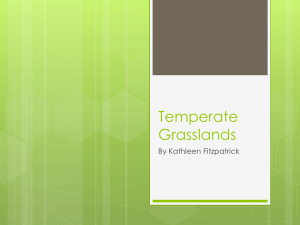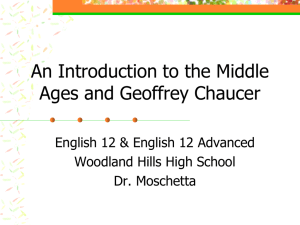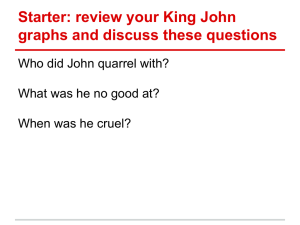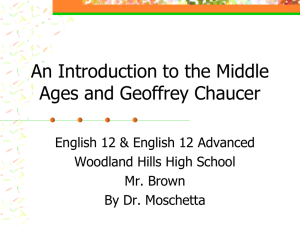(MS PowerPoint Document, 10.0 MB) Susan
advertisement
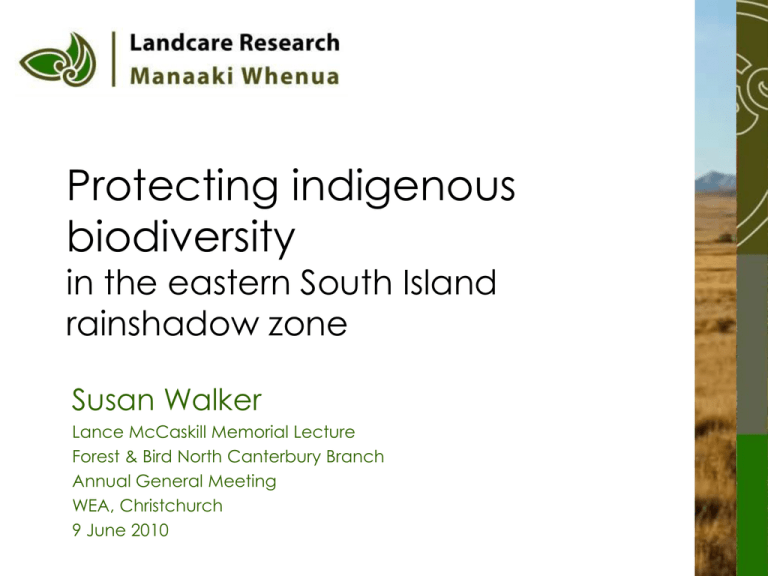
Protecting indigenous biodiversity in the eastern South Island rainshadow zone Susan Walker Lance McCaskill Memorial Lecture Forest & Bird North Canterbury Branch Annual General Meeting WEA, Christchurch 9 June 2010 Structure of my talk 1. South Island drylands: characteristics and challenges 2. Pre-settlement dryland ecology Radiations and endemism The rule and role of birds and reptiles All but fire-free 3. Humans and the transformation of ecosystems Post-settlement period Pastoral period 4. Where to from here? Four trends in drylands today The case for a return to woody dominance Retreating opportunities Structure of my talk 1. South Island drylands: characteristics and challenges 2. Pre-settlement dryland ecology Radiations and endemism The rule and role of birds and reptiles All but fire-free 3. Humans and the transformation of ecosystems Post-settlement period Pastoral period 4. Where to from here? Four trends in drylands today The case for a return to woody dominance Retreating opportunities New Zealand drylands East of main axial ranges Annual Penman Moisture Deficit >270 mm (monthly evaporation minus monthly rainfall, in mm, summed across 12 months) Area ~ 53,000 km2 (20% of NZ) http://www.doc.govt.nz/upload/documents/science-and-technical/SFC258.pdf Canterbury’s drylands ENVIRONMENT TYPES Southern and inland environments G: Inland southern South Island basins and valley floors H: Mackenzie Basin and Central Otago hillslopes Northern and coastal environments B. Dry hill country (characteristic of North Island drylands, more widespread there) D. Coastal Marlborough and Kaikoura Coast low relief alluvium & loess E: Marlborough and North Canterbury hillslopes F: Canterbury Plains, Banks Peninsula and Otago inland basin alluvium and loess South Island dryland ecosystems Characteristics Remaining native ecosystems and species are some of New Zealand’s most transformed, least protected and most threatened Threat classification for land environments Category Category Criteria Category Name 1 <10% indigenous cover left Acutely Threatened 2 10–20% left Chronically Threatened 3 20–30% left At Risk 4 >30% left and <10% protected Critically Underprotected 5 >30% left and 10–20% protected Underprotected 6 >30% left and >20% protected Less Reduced and Better Protected “THREATENED ENVIRONMENTS” Canterbury dryland environments THREATENED ENVIRONMENTS 100 80 % LOSS of indigenous cover since European settlement, by elevation zone 60 40 20 0 0 to 400m 400 to 800m Canterbury’s 103 Acutely and Chronically Threatened plants (2005 threat classification categories) 800 to 1200m 1200 to 1600m 60 No. of Acutely and Chronically Threatened plants % LOSS of indigenous cover in elevation zone Canterbury Region (~2005) >1600 m Distribution of threatened plants 40 20 0 Lowland Montane Subalpine & Alpine South Island dryland ecosystems Characteristics Remaining native ecosystems and species are some of New Zealand’s most transformed, least protected and most threatened Ecosystems are unstable (not at equilibrium) and much invaded South Island dryland ecosystems Characteristics Remaining native ecosystems and species are some of New Zealand’s most transformed, least protected and most threatened Ecosystems are unstable (not at equilibrium) and much invaded Major conservation challenges Extremely low awareness of dryland biodiversity and its protection needs (community and agencies) Limited knowledge, experience and science to support management for biodiversity protection Some of Canterbury’s dryland communities Kowhai Bush, Kaikoura Kanuka & mixed broadleaved forest and shrubland, with scattered podocarps Rakaia Island communities Kanuka forest, kowhai remnants, dry shrubland Riparian kowhai/lowland ribbonwood remnants, South Canterbury South Canterbury shrubland and forest remnants Fierce lancewood Pseudopanax ferox Hector’s tree daisy Olearia hectori Limestone communities, North Canterbury Limestone communities, South Canterbury Gentianella calcis subsp. taiko Mcleans Island grasslands Birdlings Flat/ Lake Forsyth shrublands South Branch Hurunui valley floors and gorge Ashburton Basin floor grasslands, shrublands and wetlands Mackenzie Basin foothills Mackenzie Basin floors Mackenzie Basin floor 23% of Canterbury’s ‘Threatened’ and ‘At Risk’ plants, and 11% of Canterbury’s ‘Data Deficient’ plants Mackenzie Basin floor Threatened and At Risk flora 31 species Wetlands and their margins and turfs 33 species Grassland and shrublands Mackenzie Basin floor Diverse, endemic, threatened invertebrates Moth, grasshopper and beetle faunas especially rich & distinctive Canterbury’s drylands ENVIRONMENT TYPES Southern and inland environments G: Inland southern South Island basins and valley floors H: Mackenzie Basin and Central Otago hillslopes Remaining opportunities for dryland biodiversity conservation Dryland Types 14000 Woody Grassy 12000 Intensively developed 10000 Area (km2) mixed native-exotic 8000 6000 4000 2000 0 A B C D E Dryland type F G H Structure of my talk 1. South Island drylands: characteristics and challenges 2. Pre-settlement dryland ecology Radiations and endemism The rule and role of birds and reptiles All but fire-free 3. Humans and the transformation of ecosystems Post-settlement period Pastoral period 4. Where to from here? Four trends in drylands today The case for a return to woody dominance Retreating opportunities Radiations and endemism Likely drivers •Absence of forest •New habitats & vacant niches ‘Permanent’ barriers (mountains, geological islands) •Isolation Temporary barriers i.e. glaciations Pleistocene Dryland radiations & endemism Native brooms “The species exhibit remarkable diversity, from trees to prostrate forms a few centimetres high” (Bevan Weir, NZ Rhizobia) Brachaspis grasshoppers ‘Nondiadromous’ galaxiid fishes Lowland longjaw Upland longjaw Bignose galaxiid Pencil galaxiids of the Mackenzie Basin On land, birds and lizards ruled “No where else had birds evolved to become the ecological equivalent of giraffes, kangaroos, sheep, striped possums, longbeaked echidnas, and tigers” (Tim Flannery, The Future Eaters) Mega-bird herbivory Diversity of moa sizes and feeding habits Grazers Finschs duck Teal Takahe Browsers Tree munchers Pachyornis Olearia gizzard twigs Gizzard stones Arboreal defoliators Frugivores and seed dispersers Frugivores and seed dispersers Lizards too! Pollinators Understorey scratchers and bashers Turfmaintenance crews Bird legacies in the flora Turfs Bird defense mechanisms? Inpenetrable Unappetising (dead) Armoured Inaccessible fleshy-fruited shrubs and their imitators! Big suite of endemic (non grass) herbs (many now threatened) No N-fixing herbs! Pre-settlement ecosystems All but fire-free “... a bioclimatic zone, possibly unique on a global scale, which was dry, drought-prone but free of all but infrequent fire. The anomalous result is that New Zealand possesses a suite of shrubs and trees tolerant of dry, droughty conditions but highly sensitive to fire and slow to recover in its wake” (McGlone 2001, NZJ Ecol) Tough and slow woody plants Weeping matipo, Myrsine divaricata Mountain wineberry, Aristotelia fruticosa No weedy northern hemisphere conifers to march across the landscape Tough and slow grasses •Slow nutrient acquisition •Slow nutrient use •Slow growth (Craine & Lee 2004, Oecologia) •Tough (high tissue density) leaves and roots •Low in nitrogen Few nutritious, fastgrowing sward-forming grasses Australia North America South Africa New Zealand Conservative birds and lizards • • • • Slow growth rates Long time to maturity Low fecundity Long-lived The slowest bird on earth North Island Brown Kiwi: slowest growth rate of any bird anywhere! (McLennan et al. 2007) Structure of my talk 1. South Island drylands: characteristics and challenges 2. Pre-settlement dryland ecology Radiations and endemism The rule and role of birds and reptiles All but fire-free 3. Humans and the transformation of ecosystems Post-settlement period – creation of the grasslands Pastoral period – transformation of the grasslands 4. Where to from here? Four trends in drylands today The case for a return to woody dominance Retreating opportunities Time, warming >> The arrival of humans Beech Podocarps (bird dispersed) Grasses Shrubs and small trees (wind, then bird dispersed) Clarks Junction fossil pollen trends through the Holocene (from McGlone 2001, NZ Jecol) 20 300 to 400 700 to 800 1100 to 1200 1500 to 1600 1900 to 2000 2300 to 2400 2700 to 2800 3100 to 3200 3500 to 3600 3900 to 4000 4300 to 4400 4700 to 4800 5100 to 5200 5500 to 5600 5900 to 6000 6300 to 6400 6700 to 6800 7100 to 7200 7500 to 7600 7900 to 8000 8300 to 8400 8700 to 8800 9100 to 9200 9500 to 9600 9900 to 10000 Years before present (BP) 10300 to 10400 0 Time 15 10 Frequency (n = 242) Eastern South Island fire history Frequency of dates from subfossil charcoals, South Island (summed in 100-year intervals): 30 25 5 References: McGlone (2001) NZJ Ecol; Rogers, Walker & Lee (2005) Science for Conservation Grass pollen %s in cores Enormous postsettlement increase in SI dryland grass pollen percentages 0-5% 5-10% 10-15% 15-25% 25-75% Pre-settlement Rogers, Walker & Lee 2005 Science for Conservation Post-settlement Grass pollen percentages (same data) 100 Percentage of pollen sum (%) Pre-settlement Post-settlement 80 60 40 20 0 Otago sites Rogers, Walker & Lee Science for Conservation Canterbury sites Marlborough Creation of the grasslands A few tussock species spread far and wide Slim snow tussock Midribbed snow tussock Red tussock Narrowleaved snow tussock Those with most rapid growth rates! enabled by •‘mast’ seeding: periodic massive seed production •longish (>decades?) fire return times Lloyd, Lee & Wilson (2002) Conservation Biology New Zealand grasses recover slowly from disturbance Recovery following burning Chionochloa rigida 13 Otago sites with known fire history, Measurements taken in 1989 at 1 to 26 years since burning Some characteristics have not fully recovered in 30 years Gitay, Lee, Allen & Wilson (1992) Journal of Environmental Management TIME SINCE LAST BURNING>>> New Zealand grasses recover slowly from disturbance Payton, Lee, Dolby & Mark (1986) NZJ Botany UNBURNED Bracken (for the first time) and scrub on steeper land •Different stages of recovery from infrequent Maori fires •Abundance of palatable plants •Herbivore vacuum Creation of the grasslands: summary A one-off! Unique combination of circumstances • Infrequent (>decades?) but massive fires: a radical new disturbance – A few species were pre-adapted and did well (most didn’t) • No weeds • 500 years of (virtually) no herbivores The period of pastoralism Transformation of the grasslands Began with European settlement Late 19th century over-enthusiasm “exploitative pastoralism” • More frequent burning • High stocking rates • New plants O’Connor (1986) TGML Journal The period of pastoralism Transformation of the grasslands Changes in grassland structure and composition continue today (perhaps especially in short tussock grasslands) e.g. Connor 1964; O’Connor 1982; Treskonova 1991; Rose et al. 1995; Hunter & Scott 1997; Jensen et al. 1997; Walker & Lee 2000; 2002, Duncan et al. 2001. Major transitions Tall tussock grasslands to short tussock grasslands Short tussock grasslands to degraded herbfields with much bare ground • Stature and density of the tussocks reduced • Decreased diversity and abundance of native species • Increase in non-native plants No evidence of equilibrium with pastoral management! Three synergies in the transformation of the dryland grasslands 1. Burning + grazing 2. Domestic + feral grazers 3. Reduced native dominance + exotic invasion Grazing-only effects: experimental evidence Immature tussocks Chionochloa rigida (narrow-leaved snow tussock) Carrick Range, Otago “LIGHT” grazing (control) “HEAVY” grazing Grazing affects tussock regeneration: a) reduced overall recruitment b) reduced proportions small seedlings c) reduced seedling height d) reduced proportion of seedlings distant from plant small tussocks <- -> large tussocks small tussocks <- -> large tussocks Lee, Fenner & Duncan (1993) NZJ Botany Synergy 1. Burning + grazing synergy Kevin O’Connor’s depiction Burning alone Burning + constant grazing Burning + increasing grazing O’Connor (1982) NZJ Ecology 100 100 Burning + grazing synergy: 80 80 experimental evidence 60 60 20 20 Mean number of new tillers emerged in the 2 years following spring and autumn fires 40 40 Burned only 100 80 60 0 Maungatua 870 m Spring Burned and then regrowth 0 clipped 870 m Peak Old ManmRa. 1220 m Old Man Ra. Maungatua 1220 m Coronet 1190 Spring Autumn Spring Autumn Autumn 40 20 0 Maungatua 870 m Old Man Ra. 1220 m Coronet Peak 1190 m Mark (1965) NZJ Botany Synergy 2. Domestic + feral grazers Synergy 3: Reduced native dominance + exotic invasion V & V & V & V & V & V & V& & V V & V & N # V & ## # ## ######## ### ## ## ##### # # # # ####### #### ## ######### ### # # # ###### #### # # # # # # # ### #### ## ###### # ## ## ###### # # ## # ######## ## ## ### # # # # ## ########## ## # ########### # ## # V & Sampling sites Towns Ecological Districts V V & && V ##### ########## V & ### # # ## ## ### # ## ## # ######## # ### # #### ####### ######### #### # # # ### # # ## # # ## ## ## ### # #### # # ## ## ### # # # ### # # ## # # # # #### ## # # # # # # # # # # # ## ## ## # ## ### ## ## ### ##### ### # ## # ### ### ## # ### ## # # # ### # ## ## # # # ### # ## # # #### #### ### #### ## # # ### # # ## # ## ### # # & V V & & V V & V & V & V & V & V && V V & V & V & V & V & # &# V V & ## ## ## V & V & V & V & #### & V V & V & V& & V& V ## V & V & ### ## ## ## ## # ### ### ## # ## ## ## ## ## ## #### # # # ## ## ## # # # ## ## # ## # ## # # ## ## V & ###### ####### ### # V & & V && V V V & V & V & V & V V & V& & V& Survey evidence 957 quadrats in 47 alluvial systems Walker & Lee (2000; 2002; 2003) •Fewer exotic species where structural dominance of native species is greater Native dominance 3 Average native dominance score (for quadrats with n exotic species) 2 1 0 1 2 3 4 5 6 7 8 9 10 11 12 Number (n) of exotic plant species >> 13 14 15 •Main invaders are perennial forbs and grasses •Relatively few woody invaders NATIVE TOTAL FLORA ANNUALS Dicot (non-grass!) herbs Grasses N-FIXERS Herbaceous Woody PERENNIALS Dicot (non-grass!) herbs Grasses Sedges Orchids Trees EXOTIC 247 79 4 2 12 6 0 5 7 2 116 28 35 5 35 34* 14* 101- n* = significantly more, n- = significantly fewer than expected (P<0.05 by chi-squared) Major ecological shifts (post-settlement and pastoral periods) Slow bird herbivore fauna, to boom-bust mammal fauna Slow woody/shrubby communities with numerous cryptic non-grass herbs, to new open grasslands invaded by ‘fast’ light-demanding exotic plants – sward-forming grasses & N-fixing herbs, – northern hemisphere postglacial tree “superweeds” Structure of my talk 1. South Island drylands: characteristics and challenges 2. Pre-settlement dryland ecology Radiations and endemism The rule and role of birds and reptiles All but fire-free Herbs and wood 3. Humans and the transformation of ecosystems Post-settlement period Pastoral period 4. Where to from here? Four trends in drylands today The case for a return to woody dominance Retreating opportunities Trends in dryland landscapes today Intensive agriculture: complete transformation Continued pastoral use: native grassland dominance reduced, consolidation of exotic species (especially mammal grazing-adapted light-demanding forbs and grasses) Reduced fire-frequency with relict shrubs: expansion of mixed unpalatable native-exotic woody vegetation Grazing and fire reduced: race between residual native species and new exotic species Intensive agriculture Trends in dryland landscapes today Intensive agriculture: complete transformation Continued pastoral use: native grassland dominance reduced, consolidation of exotic species (especially mammal grazing-adapted light-demanding forbs and grasses) Reduced fire-frequency with relict shrubs: expansion of mixed unpalatable native-exotic woody vegetation Grazing and fire reduced: race between residual native species and new exotic species Trends in dryland landscapes today Intensive agriculture: complete transformation Continued pastoral use: native grassland dominance reduced, consolidation of exotic species (especially mammal grazing-adapted light-demanding forbs and grasses) Reduced fire-frequency with relict shrubs: expansion of mixed unpalatable native-exotic woody vegetation Grazing and fire reduced: race between residual native species and new exotic species Expansion of mixed, native-exotic woody vegetation Trends in dryland landscapes today Intensive agriculture: complete transformation Continued pastoral use: native grassland dominance reduced, consolidation of exotic species (especially mammal grazing-adapted light-demanding forbs and grasses) Reduced fire-frequency with relict shrubs: expansion of mixed unpalatable native-exotic woody vegetation Grazing and fire reduced: race between residual native species and new exotic species Tekapo Scientific Reserve, Mackenzie Basin 1992 to 2009 1992 2009 1992 2009 Monitoring Plots 1992 - 2009 Flat Top Hill Conservation Area, Central Otago (retired & reserved 1993) 2009 Pragmatic dryland conservation goals? Return to past states is impractical Today’s grasslands are unstable, and difficult to maintain as grasslands “Ecological Integrity” (Lee et al. 2005) • Species occupancy – “native species that could and should be present, are present” • Native dominance – “native species dominate structure, composition and function” • Environmental representation – “across a full range of environments” The case for a return to woody dominance in drylands • Former widespread ecosystems were slow, woody, fire-free – wood overstorey, non-grass herb understorey • Major exotic plant invaders and competitors are lightdemanding Focus of 8-year FRST-funded ‘dryland’ research programme Facilitating transitions to native woody communities, understanding associated biodiversity benefits/changes, building understanding and awareness Retreating opportunities for dryland protection Land use intensification Land reform (Tenure Review) 14000 12000 Wood Grass Intensively developed Area (km2) 10000 8000 6000 4000 2000 0 A B C D E Dryland type F G H % of identified significant inherent values Recommendations and achievements for significant inherent values in Tenure Review to 2007 100 DOC recommended for protection as public land 90 LINZ achieved protection 80 70 60 More developable land More threatened biodiversity 50 40 30 20 10 0 <10% indigenous cover left 10–20% left 20–30% left >30% left and <10% protected >30% left and 10–20% protected Threat categories from the Threatened Environment Classification (Walker et al. 2007) Data source: Department of Conservation, unpublished data for 69 of the 90 leases reviewed 1992-2007 >30% left and >20% protected Leases retain more indigenous cover than private land in the same environments Indigenous cover retained (%) 100 Leases Private land 80 60 40 20 0 0 20 40 60 80 100 % indigenous cover remaining in environments Mackenzie Basin floor A: 1990 Converted by 1990 B: 2009 Converted by 1990 Converted between 1990 and 2009 Mackenzie Basin floor leases B: 2009 Glenmore Converted by 1990 Converted between 1990 and 2009 Sawdon Simons Pass Grays Hills Conclusion Restoring dryland ecological integrity through woody dominance may be possible BUT only if the habitat remains Thanks! Ideas, information and photos Nick Head, Peter Johnson, Jamie Wood, Marieke Lettink, Geoff Rogers, Di Lucas, Bill Lee, Kelvin Lloyd, Ines Stager, Emily Weeks Paul Martinson for his extinct bird portaits from Tennyson & Martinson, Extinct Birds of New Zealand, Te Papa Press (available from Manaaki Whenua Press)


